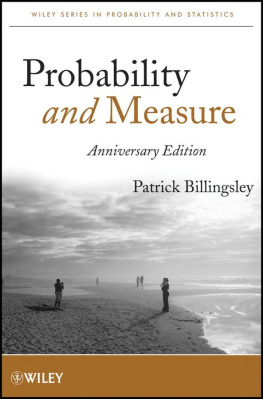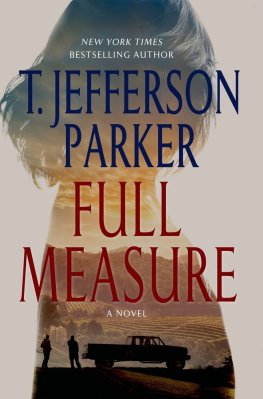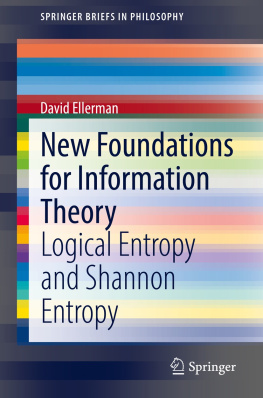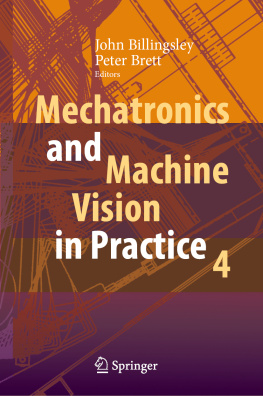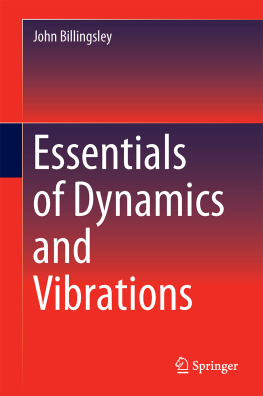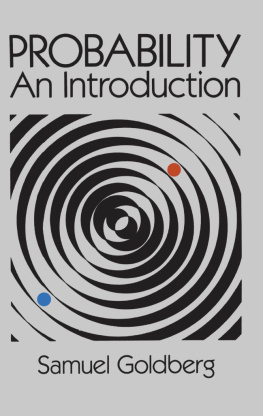Patrick Billingsley - Probability and Measure
Here you can read online Patrick Billingsley - Probability and Measure full text of the book (entire story) in english for free. Download pdf and epub, get meaning, cover and reviews about this ebook. year: 2012, publisher: Wiley, genre: Children. Description of the work, (preface) as well as reviews are available. Best literature library LitArk.com created for fans of good reading and offers a wide selection of genres:
Romance novel
Science fiction
Adventure
Detective
Science
History
Home and family
Prose
Art
Politics
Computer
Non-fiction
Religion
Business
Children
Humor
Choose a favorite category and find really read worthwhile books. Enjoy immersion in the world of imagination, feel the emotions of the characters or learn something new for yourself, make an fascinating discovery.
- Book:Probability and Measure
- Author:
- Publisher:Wiley
- Genre:
- Year:2012
- Rating:5 / 5
- Favourites:Add to favourites
- Your mark:
- 100
- 1
- 2
- 3
- 4
- 5
Probability and Measure: summary, description and annotation
We offer to read an annotation, description, summary or preface (depends on what the author of the book "Probability and Measure" wrote himself). If you haven't found the necessary information about the book — write in the comments, we will try to find it.
Probability and Measure — read online for free the complete book (whole text) full work
Below is the text of the book, divided by pages. System saving the place of the last page read, allows you to conveniently read the book "Probability and Measure" online for free, without having to search again every time where you left off. Put a bookmark, and you can go to the page where you finished reading at any time.
Font size:
Interval:
Bookmark:

Table of Contents


For further information visit: the book web page http://www.openmodelica.org, the Modelica Association web page http://www.modelica.org, the authors research page http://www.ida.liu.se/labs/pelab/modelica, or home page http://www.ida.liu.se/~petfr/, or email the author at peter.fritzson@liu.se. Certain material from the Modelica Tutorial and the Modelica Language Specification available at http://www.modelica.org has been reproduced in this book with permission from the Modelica Association under the Modelica License 2 Copyright 19982011, Modelica Association, see the license conditions (including the disclaimer of warranty) at http://www.modelica.org/modelica-legal-documents/ModelicaLicense2.html. Licensed by Modelica Association under the Modelica License 2.
Modelica is a registered trademark of the Modelica Association. MathModelica is a registered trademark of MathCore Engineering AB. Dymola is a registered trademark of Dassault Syst`emes. MATLAB and Simulink are registered trademarks of MathWorks Inc. Java is a trademark of Sun MicroSystems AB. Mathematica is a registered trademark of Wolfram Research Inc.
Copyright 2011 by the Institute of Electrical and Electronics Engineers, Inc.
Published by John Wiley & Sons, Inc., Hoboken, New Jersey. All rights reserved.
Published simultaneously in Canada.
No part of this publication may be reproduced, stored in a retrieval system, or transmitted in any form or by any means, electronic, mechanical, photocopying, recording, scanning, or otherwise, except as permitted under Section 107 or 108 of the 1976 United States Copyright Act, without either the prior written permission of the Publisher, or authorization through payment of the appropriate per-copy fee to the Copyright Clearance Center, Inc., 222 Rosewood Drive, Danvers, MA 01923, (978) 750-8400, fax (978) 750-4744. Requests to the Publisher for permission should be addressed to the Permissions Department, John Wiley & Sons, Inc., 111 River Street, Hoboken, NJ 07030, (201) 748-6011, fax (201) 748-6008, or online at http://www.wiley.com/go/permission.
Limit of Liability/Disclaimer of Warranty: While the publisher and author have used their best efforts in preparing this book, they make no representations or warranties with respect to the accuracy or completeness of the contents of this book and specifically disclaim any implied warranties of merchantability or fitness for a particular purpose. No warranty may be created or extended by sales representatives or written sales materials. The advice and strategies contained herein may not be suitable for your situation. You should consult with a professional where appropriate. Neither the publisher nor author shall be liable for any loss of profit or any other commercial damages, including but not limited to special, incidental, consequential, or other damages.
For general information on our other products and services or for technical support, please contact our Customer Care Department within the United States at (800) 762-2974, outside the United States at (317) 572-3993 or fax (317) 572-4002.
Wiley also publishes its books in a variety of electronic formats. Some content that appears in print may not be available in electronic formats. For more information about Wiley products, visit our web site at www.wiley.com.
Library of Congress Cataloging-in-Publication Data:
Billingsley, Patrick
Probability and measure / Patrick Billingsley.Anniversary ed.
p. cm.(Wiley series in probability and mathematical statistics. Probability and mathematical statistics)
"A Wiley-Interscience publication."
Includes bibliographical references and index.
ISBN 0-471-00710-2 (3rd. ed.)
ISBN 978-1-118-12237-2 (anniversary ed.)
1. Probabilities. 2. Measure theory. I. Title. II. Series
QA273.B575 1995
519.2dc20
Foreword
Patrick Billingsley, in his Preface to the Third Edition of Probability and Measure wrote that there would not be a fourth edition. More than 15 years have passed since the publication of the third edition, and almost 35 years since the first edition, and yet it remains the standard text and reference for the subject, and it remainsby the standards of graduate-level textbooks in mathematicsa bestseller. Thus, Wiley has decided to reissue the third edition in this new format, the Anniversary Edition of Probability and Measure .
Billingsley was one of the great masters of mathematical exposition and the author of five books on probability and statistics, among which three in particular, Ergodic Theory and Information, Convergence of Probability Measures , and Probability and Measure , have been highly influential, and remain widely cited. Probability and Measure is a classic among mathematical texts. It is unique in its interweaving of measure theory with probability, in the author's words, probability motivating measure theory and measure theory generating further probability. It remains the authoritative treatise on measure-theoretical probability, covering all of the essential bases of the subject in a clear and efficient manner. But it is also a highly individual work, in which the author takes care to show the reader not only the main thoroughfare, but some of the magnificent vistas lying off to the sides. These include brief excursions, many in exercise form, into optimal stopping, the theory of bold play in gambling, probabilistic number theory, and random permutations, among others. There are also side trips into the realm of theoretical statistics, notably the theory of sufficiency and the foundations of Bayesian estimation.
Coming to grips with the measure-theoretical underpinnings of probability can be a daunting task for students of statistics, computer science, and engineering. For a generation of students, Billingsley's book has shown the way up the mountain. This anniversary edition reissue of Probability and Measure ensures that the route will remain open for another generation.
Steve Lalley
Chicago, Illinois
August 2011
Preface
Edward Davenant said he would have a man knockt in the head that should write anything in Mathematiques that had been written of before. So reports John Aubrey in his Brief Lives . What is new here then?
To introduce the idea of measure the book opens with Borel's normal number theorem, proved by calculus alone, and there follow short sections establishing the existence and fundamental properties of probability measures, including Lebesgue measure on the unit interval. For simple random variablesones with finite rangethe expected value is a sum instead of an integral. Measure theory, without integration, therefore suffices for a completely rigorous study of infinite sequences of simple random variables, and this is carried out in the remainder of Chapter 1, which treats laws of large numbers, the optimality of bold play in gambling, Markov chains, large deviations, the law of the iterated logarithm. These developments in their turn motivate the general theory of measure and integration in Chapters 2 and 3.
Measure and integral are used together in Chapters 4 and 5 for the study of random sums, the Poisson process, convergence of measures, characteristic functions, central limit theory. Chapter 6 begins with derivatives according to Lebesgue and RadonNikodyma return to measure theorythen applies them to conditional expected values and martingales. Chapter 7 treats such topics in the theory of stochastic processes as Kolmogorov's existence theorem and separability, all illustrated by Brownian motion.
Font size:
Interval:
Bookmark:
Similar books «Probability and Measure»
Look at similar books to Probability and Measure. We have selected literature similar in name and meaning in the hope of providing readers with more options to find new, interesting, not yet read works.
Discussion, reviews of the book Probability and Measure and just readers' own opinions. Leave your comments, write what you think about the work, its meaning or the main characters. Specify what exactly you liked and what you didn't like, and why you think so.

